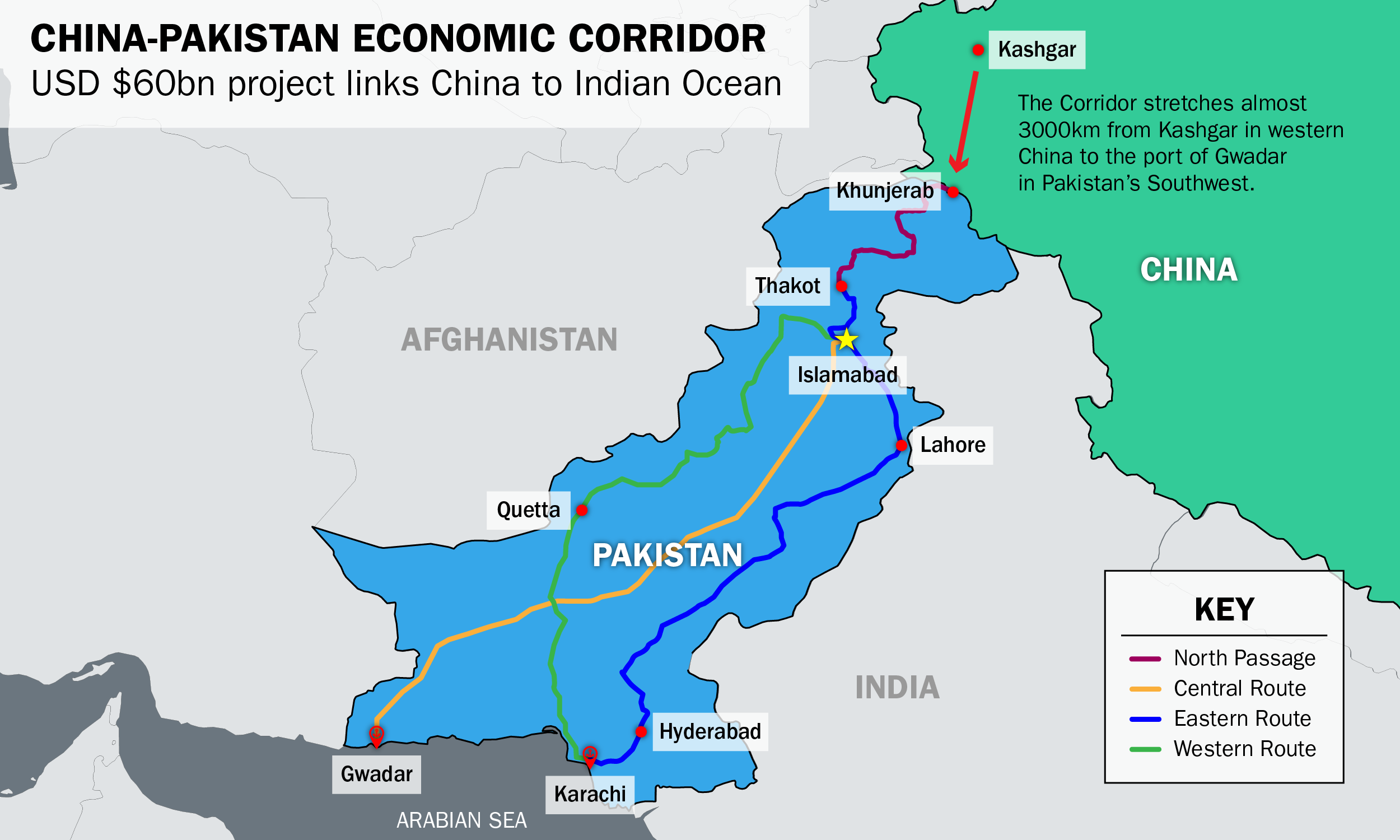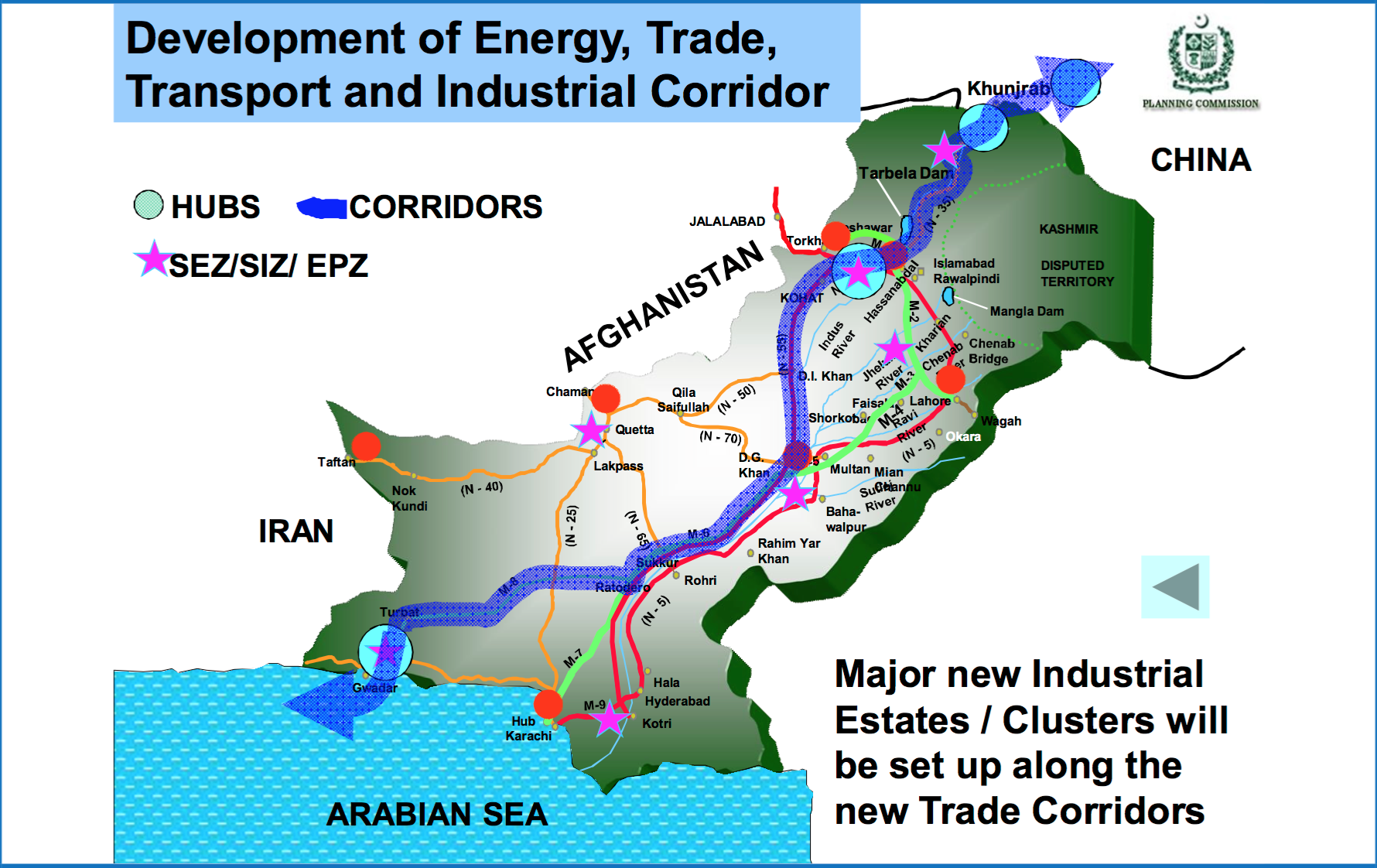The China-Pakistan Economic Corridor (CPEC) is a landmark project that aims to reshape economic ties between China and Pakistan while enhancing regional connectivity. Introduced in 2013 as a part of China’s ambitious Belt and Road Initiative (BRI), CPEC focuses on infrastructure development, energy projects, and trade facilitation. Spanning over 3,000 kilometers, this corridor connects China’s Xinjiang province to Pakistan’s Gwadar Port, serving as a critical route for trade and economic collaboration.
This article provides comprehensive China Pakistan Economic Corridor details, its significance for Pakistan and the region, and the latest updates on its progress as of 2025.
What is the China-Pakistan Economic Corridor (CPEC)?
The China-Pakistan Economic Corridor (CPEC) is a multi-billion-dollar infrastructure and development initiative aimed at improving trade routes, energy efficiency, and regional connectivity. It involves constructing roads, railways, pipelines, and energy plants, making it a cornerstone of Pakistan’s economic future.
The China-Pakistan Economic Corridor (CPEC) is a transformative initiative with the potential to reshape Pakistan’s economy and enhance regional connectivity. From infrastructure development to energy security, the benefits of CPEC are vast and far-reaching. However, addressing challenges such as debt concerns, security issues, and transparency is crucial for its long-term success.

By capitalizing on the importance of China Pakistan Economic Corridor, Pakistan can unlock new opportunities for growth, trade, and development, ensuring a prosperous future for its people and the region.
Key Features of CPEC
-
Infrastructure Development: Highways, railways, and bridges are being built to connect major cities and ports.
-
Energy Security: Energy projects include coal, hydro, solar, and wind power plants to address Pakistan’s electricity shortages.
-
Gwadar Port: Expansion of Gwadar Port as a hub for international trade.
-
Special Economic Zones (SEZs): Industrial zones to attract foreign investment and boost local industries.
CPEC is more than just a trade route; it’s a comprehensive development plan that aims to uplift Pakistan’s economy while strengthening its strategic partnership with China.
Importance of China-Pakistan Economic Corridor
The importance of China Pakistan Economic Corridor extends beyond infrastructure. It plays a pivotal role in reshaping Pakistan’s economy and positioning it as a critical player in regional geopolitics.
Economic Benefits
-
Increased Trade: CPEC simplifies trade between China and Pakistan, reducing transportation costs and improving logistics.
-
Job Creation: Thousands of jobs have been created in the construction, energy, and logistics sectors.
-
Foreign Investment: Special Economic Zones under CPEC attract global investors, boosting industrial growth.
-
Energy Supply: Energy projects under CPEC aim to resolve Pakistan’s chronic power shortages, enabling industrial and economic growth.
Strategic Importance
-
Regional Connectivity: By linking South Asia, Central Asia, and the Middle East, CPEC makes Pakistan a trade hub.
-
Geopolitical Advantage: Strengthens Pakistan’s role in global trade and enhances its strategic partnership with China.
CPEC is not just about economic growth; it’s a vision for a more connected and prosperous region.
China Pakistan Economic Corridor Details
Major Projects Under CPEC
|
Project |
Description |
Status |
|
Gwadar Port |
Modernization of port facilities for international trade |
Operational |
|
Karakoram Highway (Phase II) |
Expansion of the road network from Havelian to Thakot |
Completed |
|
ML-1 Railway |
Upgradation of Main Line-1 railway network |
Under Construction |
|
Energy Projects |
Development of coal, hydro, wind, and solar plants |
Ongoing |
Investment and Funding
CPEC has an estimated cost of $62 billion, making it one of the most significant investments in Pakistan’s history. The funding primarily comes from Chinese loans and investments, with projects divided into multiple phases for better execution.
Benefits of the China-Pakistan Economic Corridor
Economic Growth
-
Industrial Development: SEZs boost industrialization in underdeveloped regions.
-
Enhanced Exports: Improved infrastructure facilitates the export of goods, especially from Gwadar Port.
-
Improved GDP: CPEC contributes significantly to Pakistan’s GDP growth through trade and industrial activities.
Energy Security
-
Power Generation: Projects under CPEC have added over 5,000 MW of energy to Pakistan’s grid.
-
Renewable Energy: Focus on solar and wind energy contributes to sustainable development.
Improved Infrastructure
-
Transportation: Upgraded roads and railways reduce travel time and transportation costs.
-
Ports: Gwadar Port has become a critical hub for regional and global trade.
Challenges and Criticism
While the China-Pakistan Economic Corridor promises immense benefits, it also faces several challenges:
-
Debt Concerns: Critics argue that reliance on Chinese loans could increase Pakistan’s debt burden.
-
Security Issues: Ensuring the safety of workers and infrastructure remains a significant concern, especially in remote areas.
-
Transparency Issues: Lack of transparency in agreements and project details has led to skepticism among stakeholders.
-
Environmental Impact: Large-scale construction projects could impact local ecosystems and biodiversity.
Addressing these challenges is crucial for the long-term success of CPEC.

Latest Updates on CPEC (2025)
Progress in 2025
-
Gwadar Free Zone: The Gwadar Free Zone is fully operational, attracting investors from various industries.
-
Energy Projects: Over 5,000 MW of energy has been added to Pakistan’s grid, significantly reducing power outages.
-
ML-1 Railway Project: The construction of the ML-1 railway is progressing rapidly, with completion expected by 2027.
-
Digital Connectivity: New fiber-optic cables are being laid to improve internet connectivity across the corridor.
Future Prospects
-
Expansion of SEZs to boost industrial growth.
-
Enhanced trade through Gwadar Port with new shipping routes.
-
Collaboration in technology, agriculture, and education sectors.
CPEC continues to evolve, with new projects and initiatives being added to maximize its impact.
FAQs About the China-Pakistan Economic Corridor
1. What is the China-Pakistan Economic Corridor?
The China-Pakistan Economic Corridor (CPEC) is a development initiative aimed at enhancing economic connectivity between China and Pakistan through infrastructure, energy, and trade projects.
2. Why is CPEC important for Pakistan?
The importance of China Pakistan Economic Corridor lies in its potential to boost Pakistan’s economy, resolve energy shortages, and position the country as a regional trade hub.
3. What are the major projects under CPEC?
Major projects include the Gwadar Port, Karakoram Highway, ML-1 Railway, and multiple energy projects.
4. What are the challenges faced by CPEC?
Challenges include debt concerns, security issues, and lack of transparency in agreements.
5. What is the latest update on CPEC in 2025?
In 2025, significant progress has been made in energy production, Gwadar Free Zone operations, and infrastructure development.





.gif)








.gif)







Sign in
to continue to ilmkidunya.com